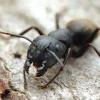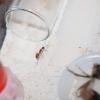- Formiculture.com
- Forums
- Gallery
- Members
- Member Map
- Chat
Coexists or war?
Started By
Guest_SolenopsisKeeper_*
, Mar 12 2022 10:45 PM
22 replies to this topic
#1
 Offline
Guest_SolenopsisKeeper_*
-
Posted March 12 2022 - 10:45 PM
Offline
Guest_SolenopsisKeeper_*
-
Posted March 12 2022 - 10:45 PM
Hello!
I was wondering what spieces could coexist in a terrariums. I do believe acorn ants could coexist with a ground dwelling species, but I am just confirming. Can territorial ants live with non-territorial ants? Or do both need to not have boundaries. If so, what ants found in Florida could be put together in a terrarium?(If size matters say 25 gallon tank). Also, could arboreal species live with ground dwelling species?
Thanks!
I was wondering what spieces could coexist in a terrariums. I do believe acorn ants could coexist with a ground dwelling species, but I am just confirming. Can territorial ants live with non-territorial ants? Or do both need to not have boundaries. If so, what ants found in Florida could be put together in a terrarium?(If size matters say 25 gallon tank). Also, could arboreal species live with ground dwelling species?
Thanks!
#2
 Offline
-
Posted March 13 2022 - 8:32 AM
Offline
-
Posted March 13 2022 - 8:32 AM
A few summers ago, I noticed two different species of ants cooperatively foraging to the point of one allowing a co-foraging species into its nest unchallenged. It got me thinking on the question you pose. While I don’t have a list of compatible species, I do have a concept of what supports cooperation vs. war between two species competing for the same food sources. I came across this paper, A Competition Hierarchy among Boreal Ants: Impact on Resource Partitioning and Community Structure, by Riitta Savolainen and Kari Vepsäläinen in Oikos Vol. 51, No. 2 (Feb., 1988), pp. 135-155. It describes a likely concept for this behavior. If you’re interested, the article is available at https://www.jstor.org/ It's behind a paywall but if you register, you're allowed access to 100 articles per month for free. I also summarized the findings here:
https://www.formicul...orage/?p=160173
#3
 Offline
-
Posted March 13 2022 - 8:44 AM
Offline
-
Posted March 13 2022 - 8:44 AM
I was going to reply to you on AntsCanada forum but realized you posted here too, I found this website where someone put four species in one vivarium: https://vivariumbuil...-in-a-vivarium/, hope this helps ![]()
- ColAnt735 likes this
Been keeping ants since January of 2021
Always try new things, even if its hard, hard is not impossible. We are smart and it's good to be smart but not too smart for your own good.
Always try new things, even if its hard, hard is not impossible. We are smart and it's good to be smart but not too smart for your own good.
#4
 Offline
-
Posted March 13 2022 - 10:05 AM
Offline
-
Posted March 13 2022 - 10:05 AM
Colonies can definitely coexist. But the extent that they coexist to depends on the species. Monogynous ant species usually I see coexist with each other as long as they don't impede on each other. Basically, they won't fight on no man's land but if it's in their territory they will fight to defend themselves.
#5
 Offline
-
Posted March 13 2022 - 12:10 PM
Offline
-
Posted March 13 2022 - 12:10 PM
Colonies can definitely coexist. But the extent that they coexist to depends on the species. Monogynous ant species usually I see coexist with each other as long as they don't impede on each other. Basically, they won't fight on no man's land but if it's in their territory they will fight to defend themselves.
Yes, and the extent of cooperation can be codified. The extent of coexistence does depend on the species’ sense of territory. If the species fiercely defends its food source, nest, and territory, they won’t play nicely with others and would be more likely to enforce a no man’s land. However, for less territorial species it’s a very different story. See the paper i cited and check this out: https://www.formicul...orage/?p=160173
#6
 Offline
Guest_SolenopsisKeeper_*
-
Posted March 13 2022 - 3:16 PM
Offline
Guest_SolenopsisKeeper_*
-
Posted March 13 2022 - 3:16 PM
Yes, and the extent of cooperation can be codified. The extent of coexistence does depend on the species’ sense of territory. If the species fiercely defends its food source, nest, and territory, they won’t play nicely with others and would be more likely to enforce a no man’s land. However, for less territorial species it’s a very different story. See the paper i cited and check this out: https://www.formicul...orage/?p=160173
Colonies can definitely coexist. But the extent that they coexist to depends on the species. Monogynous ant species usually I see coexist with each other as long as they don't impede on each other. Basically, they won't fight on no man's land but if it's in their territory they will fight to defend themselves.
So, I checked out your summary, and I have witnessed something, and I would like to know who is submissive. I saw a trail of Crematogaster(Should have collected one for species as they were a lot larger than the average Crematogaster), and a much, much, larger Camponotus media came, and seemed to touch antennae with Crematogaster, and scurried about its foraging bussiness and the Crematogaster had no reaction. Another time, I saw Camponotus discolor, and Formica subserciea literally not fighting, but almost frightening each other.(They would kind of run around each other and soon more workers came)
Also, I own these species:
Camponotus Floridanus,(1 maybe 2)
Odontomachus rugindois/relictus/brunneaus(I don’t have exact ID)(2)
Tetromorium caldarium(1)
S. Invicta(4)
What species on the list would cooperate(You can put species off the list, as I am going to catch queens in summer), or coexist,(Bets invicta would not)? Also, would phedolie co-exist would a ground dwelling Camponotus?
What species on FL would coexist with any other species in FL(not asking for a full detailed list, just any known cooperations between local species. I am curious to see if an invasive could co-exist with Natives…
Sorry if these questions are unclear/too long or detailed.
Thanks!
(Also, if you reply assume they are in a 25 or 30 gallon tank with plenty of leaf matter, plants, and some rocks and/or wood)
Edited by SolenopsisKeeper-, March 13 2022 - 3:20 PM.
#7
 Offline
-
Posted March 14 2022 - 7:00 AM
Offline
-
Posted March 14 2022 - 7:00 AM
SolenopsisKeeper,
It's hard to assess territorial, encounterer, or submissive from the scenarios you describe. Without knowing the location of the Camponotus and Crematogaster nests with respect to each other, my best guess would be that the Camponotus sp didn’t see the Crematogaster sp as a threat and the Crematogaster sp wasn’t threatened. There’s not enough information to establish a foraging hierarchy. As to the C. discolor and F. subserciea, they could both be encounterers or submissives with respect to each other. For both encounters, more observation might clarify their relationships.
As I noted in my initial response to your question, I don’t have a list of species compatible for cohabitation. Like you, I was surprised by the cooperative foraging I witnessed between two different species and it prompted me to read up on it. Sorry. I’d bet though that others on the forum might have more experience with compatible species and they’ll chime in.
#8
 Offline
-
Posted March 14 2022 - 8:40 AM
Offline
-
Posted March 14 2022 - 8:40 AM
In my experience, the best ants for vivariums are usually cryptic species as well as nonaggressive species with smaller colonies. Some good choices are odontomachus, aphaenogaster, hypoponera, cyphomyrmex, temnothorax etc.
Edited by Manitobant, March 14 2022 - 8:41 AM.
- Antkeeper01 likes this
My journals:
Polyergus Mexicanus: https://www.formicul...gs/#entry175528
Lasius minutus: https://www.formicul...cs/#entry174811
Lasius latipes: https://www.formicul...gs/#entry206449
General acanthomyops journal: https://www.formicul...yops-with-eggs/
Polyergus Mexicanus: https://www.formicul...gs/#entry175528
Lasius minutus: https://www.formicul...cs/#entry174811
Lasius latipes: https://www.formicul...gs/#entry206449
General acanthomyops journal: https://www.formicul...yops-with-eggs/
#9
 Offline
Guest_SolenopsisKeeper_*
-
Posted March 14 2022 - 1:58 PM
Offline
Guest_SolenopsisKeeper_*
-
Posted March 14 2022 - 1:58 PM
In my experience, the best ants for vivariums are usually cryptic species as well as nonaggressive species with smaller colonies. Some good choices are odontomachus, aphaenogaster, hypoponera, cyphomyrmex, temnothorax etc.
So, could Odontomachus co exist with another species you suppose? I never considered this, but Inhave found bignheaded ants living right next to Odontomachus queens and/or colonies. Also, I wonder if the ants had different nesting habitats(Living in wood and burrowing in soil), would co-exist.
As for my situations, I recently found a stick not just full of Camponotus, but also Crematogaster…. Kind of interesting, as they were living together. Crematogaster be the rats lol(In size an possibly eat scraps?)
- Antkeeper01 likes this
#10
 Offline
-
Posted March 14 2022 - 2:07 PM
Offline
-
Posted March 14 2022 - 2:07 PM
Crematogaster and pheidole are very territorial ants and have large colonies, meaning they would likely try to kill everything else in the vivarium. Camponotus are more timid, however their large colonies and individual worker size means that nothing could feasibly be kept in a tank with them.
Edited by Manitobant, March 14 2022 - 2:08 PM.
My journals:
Polyergus Mexicanus: https://www.formicul...gs/#entry175528
Lasius minutus: https://www.formicul...cs/#entry174811
Lasius latipes: https://www.formicul...gs/#entry206449
General acanthomyops journal: https://www.formicul...yops-with-eggs/
Polyergus Mexicanus: https://www.formicul...gs/#entry175528
Lasius minutus: https://www.formicul...cs/#entry174811
Lasius latipes: https://www.formicul...gs/#entry206449
General acanthomyops journal: https://www.formicul...yops-with-eggs/
#11
 Offline
-
Posted March 14 2022 - 2:16 PM
Offline
-
Posted March 14 2022 - 2:16 PM
Solenopsis molesta and related species tend to coexist well with other ants, since they don't have very much above ground territory. In fact, they like to steal resources from other ant colonies, although this doesn't usually harm the host colonies in the long run. It's hard for larger species to detect them because of their size as well. Subterranean Lasius would probably work well, along with cryptic species in general. I would recommend one territorial species and other subterranean species like the ones I mentioned above.
- Antkeeper01 likes this
"God made..... all the creatures that move along the ground according to their kinds (including ants). And God saw that it was good. Genesis 1:25 NIV version
Keeping:
Tetramorium immigrans Camponotus vicinus, modoc, novaeboracensis, herculeanus
Formica pallidefulva, argentea Solenopsis molesta
Formica cf. aserva Lasius brevicornis, neoniger
#12
 Offline
-
Posted March 14 2022 - 3:40 PM
Offline
-
Posted March 14 2022 - 3:40 PM
Lasius Flavus/Brevi should work with smaller myrmica colonies like the North American natives.
Flavus and Myrmica rubra have been recorded to live together
#13
 Offline
-
Posted March 14 2022 - 5:08 PM
Offline
-
Posted March 14 2022 - 5:08 PM
he’s in Florida…Lasius Flavus/Brevi should work with smaller myrmica colonies like the North American natives.
Flavus and Myrmica rubra have been recorded to live together
My journals:
Polyergus Mexicanus: https://www.formicul...gs/#entry175528
Lasius minutus: https://www.formicul...cs/#entry174811
Lasius latipes: https://www.formicul...gs/#entry206449
General acanthomyops journal: https://www.formicul...yops-with-eggs/
Polyergus Mexicanus: https://www.formicul...gs/#entry175528
Lasius minutus: https://www.formicul...cs/#entry174811
Lasius latipes: https://www.formicul...gs/#entry206449
General acanthomyops journal: https://www.formicul...yops-with-eggs/
#14
 Offline
-
Posted March 14 2022 - 6:31 PM
Offline
-
Posted March 14 2022 - 6:31 PM
he’s in Florida…Lasius Flavus/Brevi should work with smaller myrmica colonies like the North American natives.
Flavus and Myrmica rubra have been recorded to live together
My bad Brevis is not in Florida. That being said, both myrmica punctiventris and Lasius Americanus are found in Florida, I think they should coexist. Ditto with putting myrmica with Lasius claviger, another Florida native.
#15
 Offline
-
Posted March 14 2022 - 6:57 PM
Offline
-
Posted March 14 2022 - 6:57 PM
And any of those could go with Solenopsis molesta and related species, which also exist in Florida (not so much molesta itself, but mainly the related species; texanus, for example.)
- Antkeeper01 likes this
"God made..... all the creatures that move along the ground according to their kinds (including ants). And God saw that it was good. Genesis 1:25 NIV version
Keeping:
Tetramorium immigrans Camponotus vicinus, modoc, novaeboracensis, herculeanus
Formica pallidefulva, argentea Solenopsis molesta
Formica cf. aserva Lasius brevicornis, neoniger
#16
 Offline
-
Posted March 15 2022 - 11:19 AM
Offline
-
Posted March 15 2022 - 11:19 AM
If you put all those secretive, subterranean species in a huge tank, you’d never see them again. What’s the point then, really?
- OiledOlives likes this
"The ants are a people not strong, yet they prepare their meat in the summer." Prov. 30:25
Keep ordinary ants in extraordinary ways.
Keep ordinary ants in extraordinary ways.
#17
 Offline
Guest_SolenopsisKeeper_*
-
Posted March 15 2022 - 11:37 AM
Offline
Guest_SolenopsisKeeper_*
-
Posted March 15 2022 - 11:37 AM
I think acorn ants with a partial acorn up against the tank side would be interesting, and I will probably try to go with larger species.
Also what is a “cryptic” species? I am unfamiliar with this term, and thanks for all the answers!
Also what is a “cryptic” species? I am unfamiliar with this term, and thanks for all the answers!
#18
 Offline
-
Posted March 15 2022 - 1:03 PM
Offline
-
Posted March 15 2022 - 1:03 PM
Cryptic means hard to find, secretive.
"The ants are a people not strong, yet they prepare their meat in the summer." Prov. 30:25
Keep ordinary ants in extraordinary ways.
Keep ordinary ants in extraordinary ways.
#19
 Offline
-
Posted March 15 2022 - 1:05 PM
Offline
-
Posted March 15 2022 - 1:05 PM
cryptic refers to small species of ants that primarily live in leaf litter and on the forest floor. Some examples of cryptic ants are ponera, hypoponera, strumigenys, proceratium, stigmatomma, myrmecina etc.I think acorn ants with a partial acorn up against the tank side would be interesting, and I will probably try to go with larger species.
Also what is a “cryptic” species? I am unfamiliar with this term, and thanks for all the answers!
My journals:
Polyergus Mexicanus: https://www.formicul...gs/#entry175528
Lasius minutus: https://www.formicul...cs/#entry174811
Lasius latipes: https://www.formicul...gs/#entry206449
General acanthomyops journal: https://www.formicul...yops-with-eggs/
Polyergus Mexicanus: https://www.formicul...gs/#entry175528
Lasius minutus: https://www.formicul...cs/#entry174811
Lasius latipes: https://www.formicul...gs/#entry206449
General acanthomyops journal: https://www.formicul...yops-with-eggs/
#20
 Offline
-
Posted March 15 2022 - 5:07 PM
Offline
-
Posted March 15 2022 - 5:07 PM
I think acorn ants with a partial acorn up against the tank side would be interesting, and I will probably try to go with larger species.
Also what is a “cryptic” species? I am unfamiliar with this term, and thanks for all the answers!
Also means species that are genetically distinct but morphologically indistinguishable.
1 user(s) are reading this topic
0 members, 1 guests, 0 anonymous users




















